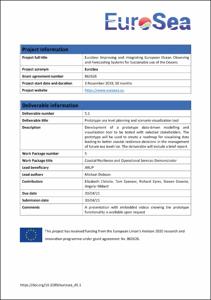| dc.contributor.author | Dobson, Michael | |
| dc.contributor.author | Christie, Elizabeth | |
| dc.contributor.author | Spencer, Tom | |
| dc.contributor.author | Eyres, Richard | |
| dc.contributor.author | Downie, Steven | |
| dc.contributor.author | Hibbert, Angela | |
| dc.date.accessioned | 2024-02-29T20:15:40Z | |
| dc.date.available | 2024-02-29T20:15:40Z | |
| dc.date.issued | 2021 | |
| dc.identifier.citation | Dobson, Michael, Christie, Elizabeth, Spencer, Tom, Eyres, Richard, Downie, Steven and Hibbert, Angela (2021) Prototype sea level planning and scenario visualization tool. EuroSea Deliverable, D5.1 . EuroSea Project , 21pp. DOI https://doi.org/10.3289/eurosea_d5.1 | en_US |
| dc.identifier.uri | https://repository.oceanbestpractices.org/handle/11329/2437 | |
| dc.description.abstract | As part of Work Package (WP) 5, “Coastal resilience and operational services demonstrator”, task 5.1.3 “Data-driven modelling and visualization for sea level guidance”, aims to improve decision making for flood risk management in the coastal zone. The primary aim is to improve understanding of how the deep uncertainty over climate change induced sea level rise can impact decision making at the early stages of the process. The deliverable 5.1, “Prototype sea level planning and scenario visualization tool” has explored this problem and delivered a visualisation prototype. During project inception, the team identified that the core problem in making informed decisions with Sea Level Rise (SLR) was that the large variation in potential future scenarios was not considered due to the complexity of the processes and calculations required to translate each physical scenario into societal impacts; it did not get through to the economic decisions. The challenge therefore was to provide a full picture of the scientific predictions and associated uncertainty within the economic decision making framework.
To tackle the challenge, a case study location was required. Previous experience within the team pointed to Hull on the East Coast of the UK as an ideal location. Built largely on low lying land on the coast, and with an excess of 100,000 properties at risk from coastal flooding, Hull faces some real challenges in how it can understand, respond to and adapt to increasing coastal flood risk with SLR into the future. The team has good links to the main risk management authority responsible for managing coastal flood risk in Hull, the Environment Agency (EA). This presented an ideal opportunity to combine a case study with targeted stakeholder engagement with the EA, and the possibility of filling some data gaps.
During the initial scoping stage of this task, a series of workshops were held between Arup, National Oceanography Centre (NOC), University of Cambridge (UCAM) and CADA Consulting (CADA). In the workshops, the problem was broken down into distinct phases and a workflow was produced to deliver the modelling and visualisation prototype, with actions assigned to Arup, UCAM and CADA. The basic premise of the proposed prototype was to visualise the economic damage resulting from a large set of SLR flood risk scenarios. This required a correspondingly large set of simulations to generate the flood risk data and, potentially, a prohibitive amount of computational expense to estimate the associated economic losses. With the aim of providing a full representation of the scientific uncertainty in the predicted damage, the aim was to reduce the detail in the engineering calculations, which translate the environmental conditions into building level flood impacts, and also the economic calculations that turn flood impacts into damage estimates. This was the alternative to reducing the number of SLR scenarios to be visualised. During this scoping stage, a concept User Interface (UI) was also developed.
The modelling process can be summarised in 3 steps:
1) Specifying nearshore hydrodynamic conditions (still water level, storm surge profile, wave conditions).
2) Calculating the pathway of water onto the land through overflow and wave overtopping of high ground or defences.
3) Determining how the flood water spreads on land.
This was a significant undertaking and a core element of the task. UCAM developed an approach to bring together all elements in a streamlined model workflow. The aim of the approach is for this workflow to be
replicable in alternative locations. However, only the case study location has been modelled within the scope of this project.
Alongside the development of the modelling approach, a visualisation prototype was designed and built to receive, process and visualise the modelling outputs. The modelling method results in a very complex set of data focussed on a wide range of “scenarios”. The scenarios are created by three primary sources of uncertainty:
1. Emissions scenario (e.g. RCP4.5)
2. Model uncertainty for sea level rise predictions within a given emissions scenario (e.g. 50th percentile)
3. The multiple wave possibilities combined with the storm and tide extreme still water level combination
The final dimension is the geographical distribution of the flooding; where does the flooding occur and what localised damage is it causing? The spatial calculation grid was simplified but still contained 1000 hexagonal regions to cover the flood extent within Hull.
Altogether, this results in thousands of potential scenarios across 80 years and a thousand geographical points, all requiring an economic damage calculation. The sheer volume of data creates a challenge; how can the user understand the data and how can it be used to inform decisions on the impact of sea level rise? This issue has been resolved through the creation of a visualisation prototype which is a web-based interface to the data, allowing the user to easily select a scenario and, importantly, rapidly change the scenario and compare to other scenarios. In this way the user can immerse themselves in the data and get a feel for how decisions on the originating uncertainty levels (items 1 to 3 above) alter the overall flooding in the region, its distribution and the resulting economic impact.
It was important to achieve sufficiently fast functionality of the visualisation prototype as significant delays between scenario changes would quickly lose the interest of the user and limit the potential for interactive data exploration. To achieve this, the calculations were pre-processed before uploading a static data set to the visualisation prototype. This allowed the incorporation of two different ways to view the data. A single scenario view where the impacts of the chosen scenario inputs can be examined with maps, graphs and metrics. Then a two scenario option where different inputs can be compared alongside each other to understand how certain changes in the physical inputs manifest in the impacts.
Initial stakeholder feedback from the Environment Agency on the visualisation protype was positive and included acknowledging:
• the value in this approach as it explains uncertainty and helps people to understand their own appetite for risk.
• This is a good means of visualising sea level change since people often struggle to understand this in a meaningful way.
• It is useful to see how a change in one small parameter can affect a whole city
• Different stakeholders will want the information at different scales
The future development of this modelling approach and visualisation prototype may consider the following:
• The balance of modelling accuracy with speed of processing according to the location and user needs
• The incorporation of quick defence raising assessments
• Enhanced economic calculations (more detail and or wider economic metrics), again balancing the needs for more information with speed of processing
• Different methods of visualisation, such as 3D, depending on the stakeholder and user needs
• Robustness and testing of the calculations in readiness for commercialisation
This task has proven that the prototype sea level planning and scenario visualization tool is a viable prospective means of communicating the high degree of uncertainty that is inherent in current projections of sea level extremes Future commercialisation depends on follow-on funding to implement the recommended development work. The task consortium plans to continue engagement with existing stakeholders to explore use cases and funding opportunities to refine the prototype in respect of the Humber case study area. At the same time, the task consortium is keen to identify other potential beneficiaries and funding bodies (port operators, coastal communities, insurers, planning authorities etc), who might support the enhancement of the prototype to a commercial standard in other geographical areas. | en_US |
| dc.description.sponsorship | European Union Horizon H2020 | en_US |
| dc.language.iso | en | en_US |
| dc.publisher | EuroSea Project | en_US |
| dc.rights | Attribution 4.0 International | * |
| dc.rights.uri | http://creativecommons.org/licenses/by/4.0/ | * |
| dc.subject.other | Sea level planning | en_US |
| dc.subject.other | Flood risk management | en_US |
| dc.title | Prototype sea level planning and scenario visualization tool. | en_US |
| dc.type | Report | en_US |
| dc.description.status | Published | en_US |
| dc.format.pages | 21pp. | en_US |
| dc.identifier.doi | https://doi.org/10.3289/eurosea_d5.1 | |
| dc.subject.parameterDiscipline | Sea level | en_US |
| dc.subject.dmProcesses | Data visualization | en_US |
| dc.description.currentstatus | Current | en_US |
| dc.description.eov | Sea surface height | en_US |
| dc.description.maturitylevel | Pilot or Demonstrated | en_US |
| dc.description.adoption | Novel (no adoption outside originators) | en_US |
| dc.description.adoption | Multi-organisational | en_US |
| dc.description.adoption | International | en_US |
| dc.description.methodologyType | Reports with methodological relevance | en_US |
| obps.contact.contactname | Michael Dobson | |
| obps.contact.contactemail | michael.dobson@arup.com | |
| obps.resourceurl.publisher | https://oceanrep.geomar.de/id/eprint/54741/ | |
 Repository of community practices in Ocean Research, Applications and Data/Information Management
Repository of community practices in Ocean Research, Applications and Data/Information Management

